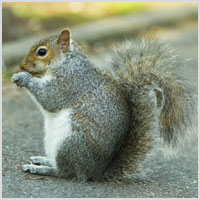Gery Squirrel
 Common Name:Gery Squirrel
Common Name:Gery Squirrel
Scientific Name: Sciurus Carolinensis
Introduction:Grey squirrels are highly prolific adaptable mammals. They were introduced to Britain from North America in 1876 and 1929. Since then, grey squirrels have spread throughout the country and has largely displaces the native Red squirrel. They are known to be a nuisance throughout the country, especially in urban areas where they cause damage to houses, buildings or structures being used for nesting, shelter or for food storage.
Recognition: Grey squirrels are slightly different from the native red squirrel and can be mistaken. The fur colour can change slightly due to outdoor conditions. They are much larger than a red squirrel, with a larger bushy tail. Their upper coat is predominately grey, with a little reddish tinge, white underneath (stomach) but in the summertime the upper coat is brownish grey in colour.
Biology:The body length of an adult grey squirrel is approximately 25cm long and their tail is about 22cm, with the adult weighing about 500gm. Grey squirrels build their nest mainly with twigs and leaves outdoors, they can also use tree hollows as dens, indoors they will use insulation, paper, plastics etc. Grey squirrels are mammals and therefore have live babies. They breed twice a year, the first litter being born in February or March, and after gestation period of 45 the first litter is then weaned at 10 weeks old. The second litter are born between June and July and they leave the nest in August or September, on average every litter may have about 3-4 young. The first litter can start breeding as early as six months, but usually they start breeding at one year old. The grey squirrel can live up to 20 years old in captivity, but outdoors can live up to 12 years old depending on conditions. Their droppings vary in shape and colours depending on their diet. They feed on nuts, pine cones, vegetables, fruits, leaves, seeds etc.
Habits: Grey squirrels are very good climbers and active during daytime and can be seen very easily. In urban areas they are spotted in trees, parks, gardens, houses, attics, roads etc. while searching for food or shelter. Outdoors they will dig up vegetable and flower gardens, raid bird feeders, and often strip the bark from trees. They are fond of burying food items, and their diggings can be very destructive to gardens parks and other landscaped areas. Even if grey squirrels are not spotted indoors, they can be heard by their loud scratching noise, running through the cavity walls, and attics. They can be very destructive indoors by stripping or chewing on rafters, floor joists, electric cables and insulation, plastic waste pipes, etc.
Potential harm: Grey squirrels can cause lots of damage to buildings, houses, structures, but can be very expensive and sometimes even life threatening, for example, electric fires when insulation is stripped off, or cause water damage when waste pipes have been chewed off.
Control: there are various methods of controlling grey squirrel which can be done professionally or by yourself with professional advice. Some control methods that can be used when building, renovating or in an existing building or house are:
Ensure that the gaps between the rafters are blocked when installing a new roof Wire netting can be used around roof that already being built (wire netting gaps should not be more than 8mm). Holes drilled through the walls or foundations by utility companies when installing pipelines or cable lines should be blocked off after completion. Overhanging branches that reaches the roof top or next to the house or building should be trimmed. A smooth metal sleeve should be placed around trees in the garden to prevent them from climbing (metal sleeves should be about 0.75m deep and place no less than 1.5 m off ground).
Drey (nest) poking and shooting Trapping, (only approved trap should be used) e.g. cage traps, and spring traps. Poison baiting (using only approved pesticide)Proofing - blocking up holes or gaps.
They often gain access through vents, broken windows, knotholes, and construction gaps under eaves and cables. Occasionally, the chimney and fireplace provide an entry route.
Squirrels have a remarkable ability to destroy wooden shakes and shingles, cedar seeming to be their favourite. The amount of structural damage may at times be severe. They can be particularly destructive to summer or vacation cabins which are vacant during part of the year, as they are free to continue their activities until the owners return. Garages, barns, stables, tool sheds and other buildings often serve as homes for tree squirrels. Call Solution Pest Control today for pest control in London.




























